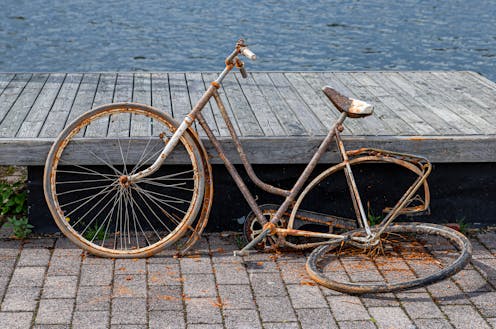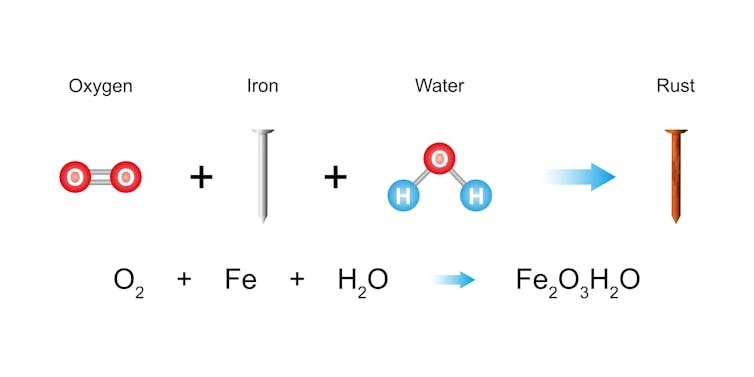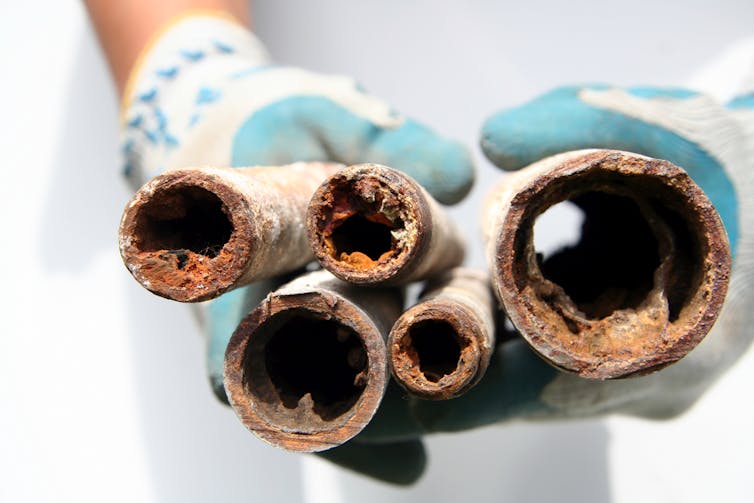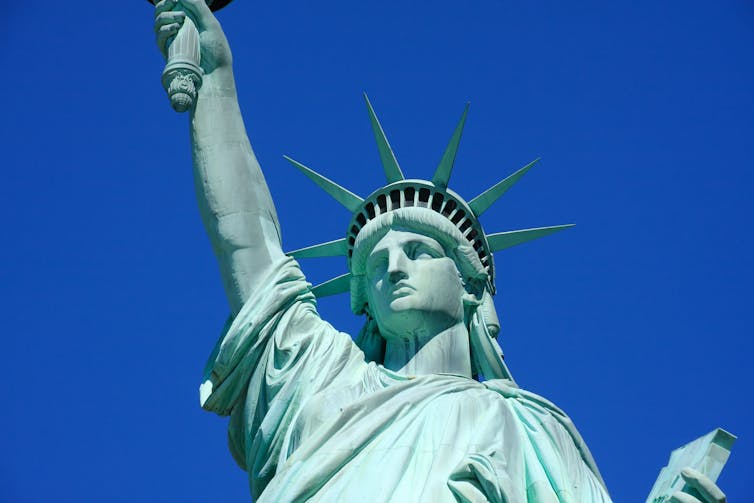What is rust? A materials scientist explains metal’s crusty enemy
- Rust is a natural process that occurs when iron or steel reacts with oxygen and moisture, leading to the formation of iron oxide (rust) and causing metal to break down.
- The combination of rain, exposed metal, and time can trigger rusting on objects like bicycles, cars, bridges, and ships, which can lead to costly repairs and environmental damage.
- Understanding the chemistry behind rust has led to various methods to slow it down or stop it altogether, such as painting the metal surface, keeping metal dry, galvanization, and using corrosion-resistant materials like stainless steel.
- Rust is not just limited to iron and steel; any metal can chemically degrade due to reactions with environmental factors like oxygen and moisture, leading to forms of corrosion like patina on copper statues.
- By studying the atomic level of rusting, scientists can develop new materials that last longer and work better in everyday life, such as stronger bridges, more efficient batteries, and safer airplanes.

Curious Kids is a series for children of all ages. If you have a question you’d like an expert to answer, send it to CuriousKidsUS@theconversation.com.
What is rust? – Henry E., age 13, Boston, Massachusetts
Imagine leaving your shiny metal bicycle outside in the rain. As water pools on its surfaces, oxygen from the air lingers nearby, and together they begin to quietly attack the metal.
The iron in the bike and the oxygen and water in the environment together undergo a chemical reaction. It forms iron oxide – better known as rust – which accumulates over time. This reddish-brown, flaky substance is more than just ugly; it’s a sign that the metal is breaking down.

Ali Damouh/Science Photo Library via Getty Images
Chemists call this process oxidation. You can think of iron as like a superhero — tough, durable and shiny — until it meets its kryptonite: moisture and air. Water helps iron atoms more easily shed their electrons, which are negatively charged particles. Oxygen acts like a tiny electron thief, stealing those electrons and leaving the metal weak and crumbly.
The shiny, metallic iron used in homes and industry is a refined form of what is found in nature — iron ore. Rust is a natural process — the refined iron is essentially trying to return to its original oxidized, stable state: iron ore.

chimmy/E+ via Getty Images
From bikes and cars to bridges and ships
From household fixtures to monumental machines, rust moves in wherever metal meets moisture and time.
On bikes and cars, the combination of rain and exposed metal often triggers a full-blown rust party, eating away at frames and undercarriages. Old water pipes are another hot spot — over time, they corrode from the inside, often leaking brown, rusty water into sinks and tubs. In the kitchen, standing water left around sinks or faucets can lead to yellow-orange rust stains that are as stubborn to remove as they are unsightly.
On a much larger scale, rust can wreak havoc on ships and bridges. Corroded hulls can lead to oil leaks or even catastrophic sinking, costing the maritime industry billions of dollars each year in repairs and environmental damage.
And here’s a twist – salt speeds up the rusting process. In snowy regions, road salt doesn’t just melt ice; it also turbocharges oxidation, accelerating the corrosion process. That’s why cars in snowy places might rust faster.

ErickN/iStock via Getty Images Plus
Rust is the term for the specific type of corrosion that occurs in iron or steel. But any metal can chemically degrade due to reactions with environmental factors like oxygen and moisture.
Even old statues aren’t immune. Those greenish-blue figures you see in parks and plazas? That’s not paint; it’s patina, the copper version of rust. Though more visually appealing, patina is still a form of corrosion.
How can you stop rust?
By understanding the chemistry behind rust, people have found smart ways to slow it down or even stop it altogether, protecting everything from bridges to bicycles.
One of the simplest methods is to paint the metal surface. Paint acts like a waterproof jacket, sealing the metal off from air and moisture – the two key ingredients for rust.
Keeping metal dry is another practical defense. Tools are often stored in dry spaces or alongside dehumidifiers to minimize moisture.
Another technique, called galvanization, coats one metal with a more reactive one, like zinc. Zinc corrodes more easily than iron, forming a stable layer of zinc oxide when exposed to air and moisture. The zinc oxide is a protective barrier to further corrosion – until it gradually wears away, leaving the underlying iron vulnerable to rust once again.
And then there’s stainless steel: a corrosion-resistant mixture, called an alloy, of iron with other metals, such as chromium. When exposed to air, chromium undergoes its own version of rusting, forming a stable layer of chromium oxide.
This layer is extremely thin, 100,000 times thinner than a single strand of human hair. It is invisible to the naked eye, sticks tightly to the metal surface and prevents further oxidation. The chromium oxide layer is also self-healing — if scratched, the exposed chromium quickly reforms the protective barrier. That’s why stainless steel is used in everything from kitchen sinks to surgical tools.
Watching rust on the atomic level
I’m a materials scientist who uses advanced imaging tools, like transmission electron microscopes, to study how metals oxidize at the atomic scale. We can actually watch as tiny metal atoms lose electrons and oxygen atoms gain them, undergoing corrosion in real time.
For instance, in one study, we observed the way a thin layer of aluminum oxide forms instantly when aluminum is exposed to oxygen or water vapor. This oxide layer doesn’t flake off like rust on iron; instead, it forms a uniform, tightly bonded protective coating that blocks any more oxygen and water from reaching the underlying metal. That’s why aluminum resists continued corrosion – unlike iron, whose rust layer is porous, allowing the reaction to keep going.
Oxidation can be harmful, causing rusting, or beneficial when harnessed to protect metals instead. By observing these processes in real time, my colleagues and I aim to create materials that last longer and work better in everyday life — for example, to construct stronger bridges, more efficient batteries and safer airplanes.
Hello, curious kids! Do you have a question you’d like an expert to answer? Ask an adult to send your question to CuriousKidsUS@theconversation.com. Please tell us your name, age and the city where you live.
And since curiosity has no age limit – adults, let us know what you’re wondering, too. We won’t be able to answer every question, but we will do our best.
![]()
Guangwen Zhou receives funding from the National Science Foundation, and the Office of Basic Energy Science, Department of Energy
